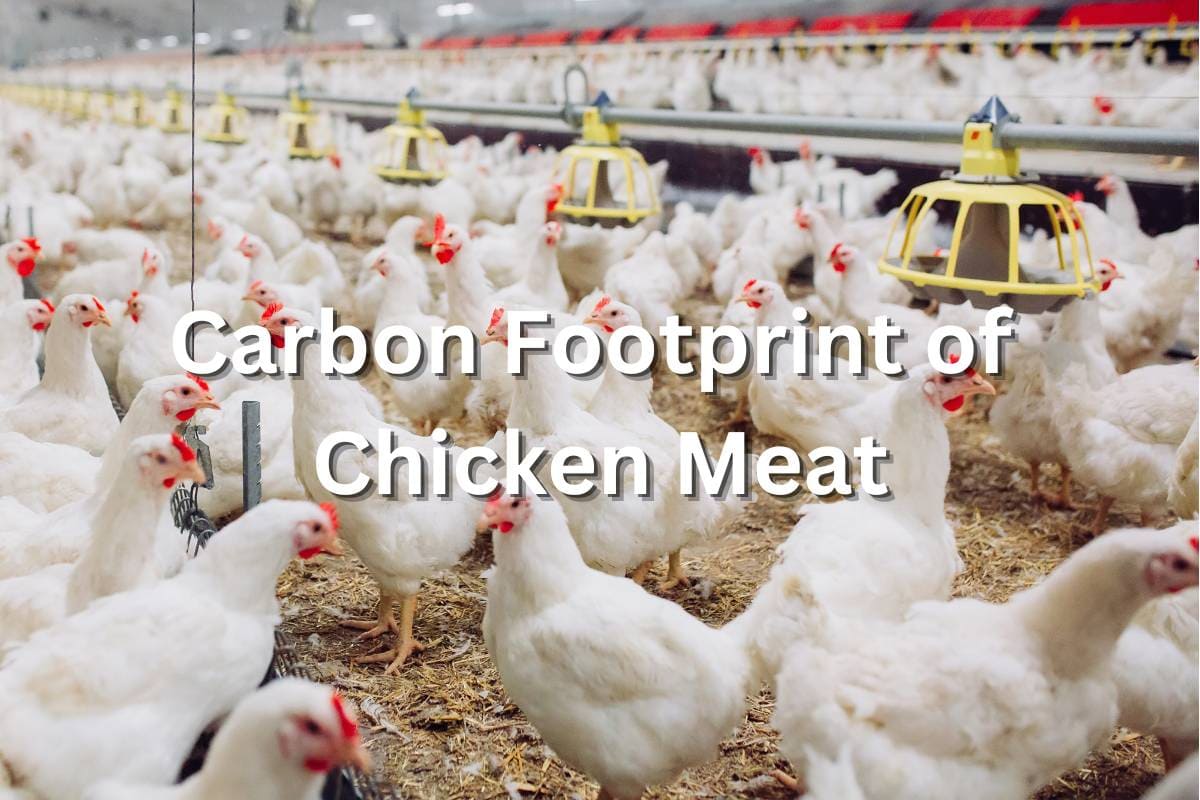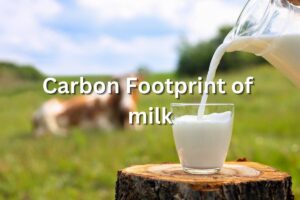The carbon footprint of chicken meat is approximately 9.87 kg of CO2 equivalent per kilogram (or about 4.5 lbs CO2e per pound) of meat produced. This makes it a lower-impact meat compared to the carbon footprint of beef, which has a significantly higher footprint of about 99.48 kg CO2e per kilogram (or about 45.1 lbs CO2e per pound).
Factors Contributing to the Carbon Footprint of Chicken Meat
- Feed Production: Growing feed crops requires significant amounts of land, water, and fertilizers, which contribute to greenhouse gas emissions.
- Manure Management: The handling and storage of chicken manure release methane and nitrous oxide, potent greenhouse gases.
- Energy Use: The energy required for housing, processing, and transporting chickens adds to their carbon footprint.
Interesting Facts
- Land Use: Chickens require less land compared to cattle, making them a more efficient source of animal protein.
- Water Efficiency: Chicken production generally uses less water than beef or pork.
- Rapid Growth: Chickens grow faster and convert feed to meat more efficiently than other livestock, reducing the overall environmental impact.
Tips to Reduce the Carbon Footprint of Chicken Meat
- Buy Locally: Purchasing locally sourced chicken reduces transportation emissions.
- Opt for Organic: Organic farming practices often use fewer synthetic inputs, leading to lower emissions.
- Reduce Waste: Plan meals to avoid food waste, which indirectly contributes to emissions.
- Support Sustainable Brands: Choose products from companies committed to reducing their environmental impact.
Effort in reducing the environmental impact
Tyson Foods, one of the largest meat producers, has committed to reducing its greenhouse gas emissions by 30% by 2030. The company is investing in renewable energy and sustainable farming practices to achieve this goal. Tyson Foods is working on initiatives such as improving feed efficiency and incorporating better manure management practices to lower their environmental impact.
Sanderson Farms, now part of Cargill, has also taken steps to improve sustainability in their operations. They are focusing on reducing water usage and improving feed conversion efficiency. These efforts are part of a broader industry trend towards more sustainable practices in poultry farming.
Which Meat Has the Highest Carbon Footprint?
Beef has the highest carbon footprint among meats. According to the data from Statista, the carbon footprint of beef from a beef herd is approximately 99.48 kilograms of CO2 equivalents (CO2e) per kilogram of meat produced (or about 45.1 lbs CO2e per pound). This high footprint is due to several factors:
- Methane Emissions: Cattle produce significant amounts of methane, a potent greenhouse gas, through their digestive processes.
- Feed Production: The cultivation of feed crops for cattle requires large amounts of land, water, and fertilizers, contributing to additional emissions.
- Land Use: Beef production often involves deforestation to create pastureland, which releases stored carbon from trees and soil into the atmosphere.
What Meats Have the Lowest Carbon Footprint?
When focusing solely on animal-based proteins, meats with the lowest carbon footprints include:
- Chicken:
- Carbon Footprint: Approximately 9.87 kg CO2e per kilogram (about 4.5 lbs CO2e per pound).
- Reasons: Chickens are efficient at converting feed to meat, require less land, and produce fewer methane emissions compared to ruminants like cattle and sheep.
- Pork:
- Carbon Footprint: Approximately 12.31 kg CO2e per kilogram (about 5.6 lbs CO2e per pound).
- Reasons: Pigs are more efficient than cattle in feed conversion and have lower methane emissions. However, their footprint is higher than chickens due to larger land and water requirements, as well as manure management challenges.
- Farmed Fish (e.g., salmon):
- Carbon Footprint: Approximately 3.5 to 5.9 kg CO2e per kilogram (about 1.6 to 2.7 lbs CO2e per pound, variable depending on species and farming practices).
- Reasons: Farmed fish have efficient feed conversion rates and lower land use impacts compared to terrestrial livestock. However, the footprint can vary significantly based on feed sources and farming practices.
What Is the Carbon Footprint of Chicken vs Pork?
The carbon footprint of chicken is approximately 9.87 kg of CO2 equivalents per kilogram of meat produced (about 4.5 lbs CO2e per pound), while the carbon footprint of pork is around 12.31 kg CO2e per kilogram (about 5.6 lbs CO2e per pound).
Detailed Comparison
| Meat Type | Carbon Footprint (kg CO2e per kg) | Carbon Footprint (lbs CO2e per lb) | Feed Efficiency | Land Use | Methane Emissions | Water Use |
|---|---|---|---|---|---|---|
| Chicken | 9.87 | 4.5 | High (Efficient feed-to-meat conversion) | Low (Requires less land than beef/pork) | Low (Negligible compared to ruminants) | Low (Less water than beef/pork) |
| Pork | 12.31 | 5.6 | Moderate | Moderate (More than chicken, less than beef) | Moderate (Methane from manure management) | Moderate (More than chicken, less than beef) |
| Farmed Fish | 3.5 – 5.9 | 1.6 – 2.7 | High (Efficient feed-to-meat conversion) | Low (Minimal land use for aquatic farming) | Very Low (No significant methane production) | Variable (Depends on farming practices) |
| Beef | 99.48 | 45.1 | Low (Less efficient feed-to-meat conversion) | High (Significant land use for grazing and feed) | High (Significant methane emissions from digestion) | High (Significant water use for feed crops) |
Conclusion
In summary, beef has the highest carbon footprint among common meats due to methane emissions, feed production, and land use changes. Chicken and pork have lower carbon footprints, with chicken being the more environmentally friendly option between the two. Choosing meats with lower carbon footprints, like chicken or even better, plant-based proteins, can significantly reduce your environmental impact.
Sources
- Our World in Data: The Carbon Footprint of Foods
- Statista: Average Greenhouse Gas Emissions per Kilogram of Major Food Products Worldwide
- Phys.org: Can Factory Chicken Really Help Save the Climate?
- Statista: Average Greenhouse Gas Emissions per Kilogram of Major Food Products Worldwide
- The Commons Earth: Beef vs Chicken: Which Meats Have the Highest Carbon Footprint?




